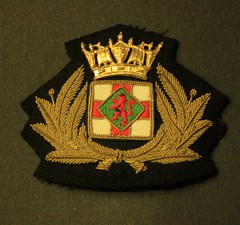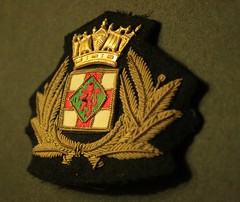Metal, gold wire and colored thread on wool backing.
Circa 1960s.
With contemporary events unfolding regarding the catastrophe in the Gulf, it is worth pausing for a moment to think about transport of petroleum products. One of the safest, economical and most expedient methods to transport liquid petroleum and its derivatives is via ship. In fact, about 34% of all worldwide seaborne trade is devoted to the transport of oil. This entry is the first of several regarding oil tanker fleets and officer insignia.
British Petroleum was originally formed as the Anglo-Persian Oil Company in 1909 to exploit oil deposits in Persia. The British Tanker Co. Ltd started in 1915 to handle sea transport and achieve a contained, integrated oil company model akin to its American counterparts. The parent group was renamed the Anglo-Iranian Oil Company in 1935. In 1951 the company's Iranian assets were nationalized, a crisis partly resolved by negotiation in 1954 when the company was re-named British Petroleum. In 1955, the fleet was re-christened BP Shipping. During the 1970s BP extended its oil interests to the North Sea and Alaska, and eventually moved to major oil fields in the Middle East and Gulf of Mexico. The fleet and its manning remained in the province of BP until 1986 when staffing went the way of a modern crimping system known as "agency manning" concurrent with BP re-flagging its fleet under various flags of convenience.
At present, BP Shipping is based out of Singapore and operates a fleet of 77 vessels and charters an additional 115. Its vessels are comprised of crude oil tankers, product tankers and LNG (liquefied natural gas) carriers. In its employ are some 2300 mariners and 600 onshore personnel. In all, 50% of BP's maritime cargo is carried on these ships worldwide. BP remains one of the few major oil producing corporations that continues to man a fleet under its own house flag.
British Petroleum Shipping hat badges may be found in three distinct variations:
1. 1915-1926. Merchant Navy-style hat badge with the current house flag - a red flag with a horizontal white band expanded at the centre in the form of a circle, the band bearing the black letters "BTC", the "T" being larger. I have read of the red being bordered in black; however I have yet to see an example.
2. 1926-1955. Similar to the illustrated hat badge, with then current house flag - a St. George's flag with a green diamond in the center - with a golden lion passant gardant above all.
3. 1955-1968 (present?). The illustrated badge; the golden lion replaced by a red lion rampant.
Images and analysis of several of the older badges may be found here.
References:
Bill Harvey, BP Tankers: A Group Fleet History.
British Petroleum Shipping Co. Officer hat badge, obverse
Metal, gold wire and colored thread on wool backing.
Circa 1960s.
In terms of British hat badges, the BP Shipping follows the British standard design of house flag as central device, Royal Navy wreath and Tudor maritime crown surmounting all. Over time, the embroidered leaves have grown thicker; and catalogs may denote the badge as belonging to the agency placing Deck and Engineering officers aboard BP vessels - Chiltern Maritime Ltd.

British Petroleum Shipping Co. Officer hat badge, detail.

British Petroleum Shipping Co. Officer hat badge, variation.
Circa 1950s.
Note the bronze-toned Tudor crown and the British Merchant Navy-style wreath.

British Petroleum Shipping Co. Chief Petty Officer hat badge, obverse.
Metal, gold wire and colored thread on wool backing.
Circa 1960s.

British Petroleum Shipping Co. Chief Petty Officer hat badge, detail.

British Petroleum Tanker Co. Ltd.
House Flag.
914.4 x 1422.4 mm
Circa 1955-67
The house flag of the BP Tanker Co. Ltd. On a white field, there is a red St. George's cross with a green diamond in the center, bearing a red lion, rampant. This design was in use from 1955 to 1968 and was re-introduced in 1984. The flag is made of a wool and synthetic fibre bunting. It has a cotton hoist and is machine sewn. The lion is printed. A rope and two Inglefield clips is attached.

British Petroleum Tanker Co. Ltd.
House Flag.
Circa 1940s.
The house flag of the BP Tanker Co. Ltd. from the 1940s. On a white field, there is a red St George's cross with a green diamond in the center, bearing a golden lion passant gardant. This design was in use from 1926 to 1955. The flag is made of a wool and cotton bunting. It has a cotton hoist and is machine sewn. The lion is printed.


